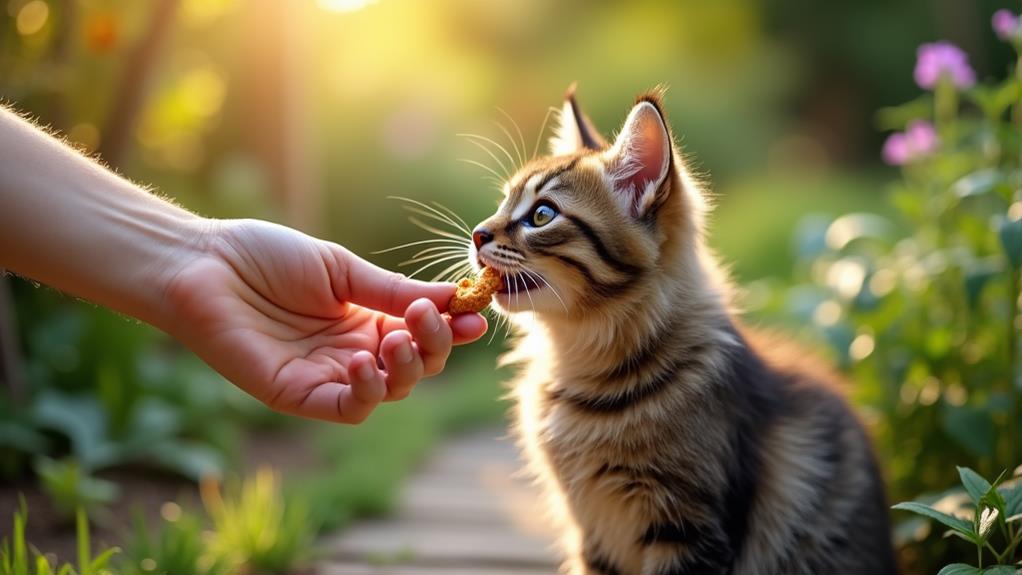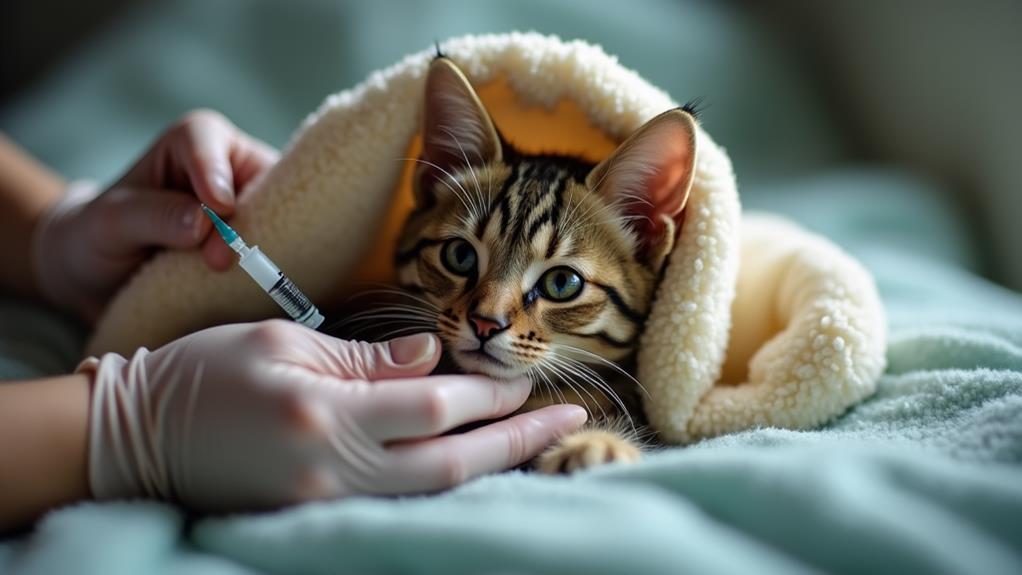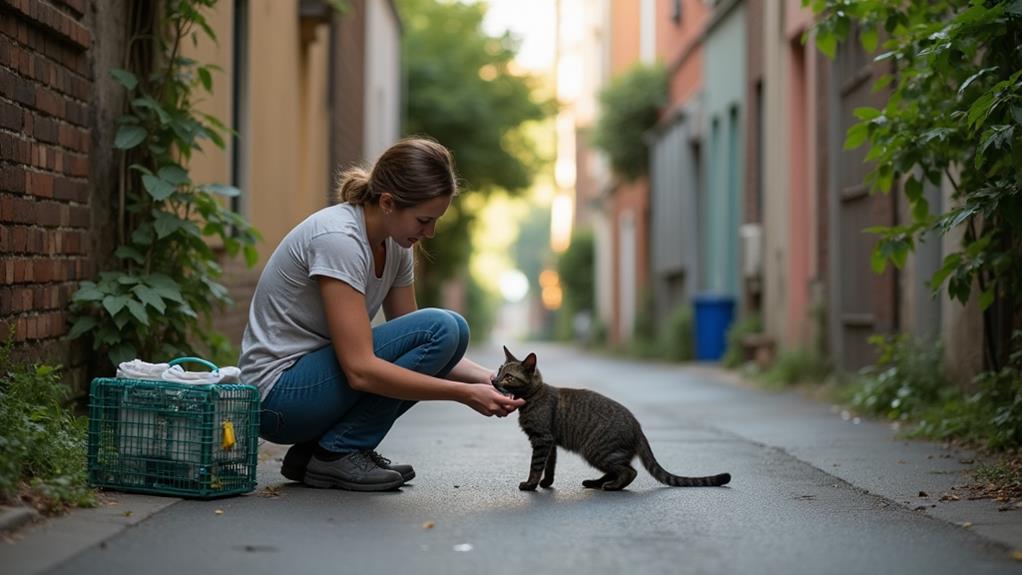How to Deworm a Feral Cat: Simple Steps for Parasite Prevention

Deworming feral cats is key to keeping them healthy and the entire colony thriving. Start with a solution like Panacur™ or food-grade diatomaceous earth, mixed in with cat food to guarantee it's eaten. Use one heaping teaspoon for adults and half for kittens, providing access for seven days to tackle parasites. Monitor the cats' behavior and energy to gauge the treatment's effectiveness and plan follow-up deworming every three weeks. Involve your community for better pest control and share tips on reducing parasite exposure. Following these steps will improve your understanding of maintaining a healthier feral cat population.
Importance of Deworming
Deworming feral cats is crucial for maintaining their health and well-being. Parasites such as worms can wreak havoc on a cat's body, leading to nutritional depletion and a weakened immune system. This makes feral cats more prone to diseases like respiratory infections. By focusing on parasite prevention, you're not only improving the immediate pet health of these animals but also elevating their resilience against future illnesses.
When you notice signs like a rough coat or weight loss in feral cats, it's a clear indicator that they need deworming. These symptoms shouldn't be ignored, as they suggest the presence of parasites that can severely affect their health. Regular deworming interventions can greatly improve the health and longevity of feral cat populations, making it a key component in managing feral colonies effectively.
Implementing a consistent deworming schedule helps control parasite infestations over the long term. By targeting multiple types of worms with effective methods, you guarantee feral cats remain healthy and lively, reducing the strain on their immune systems. In doing so, you contribute to a healthier environment for the entire feral colony, emphasizing the crucial role of deworming in pet health management.
Choosing Deworming Methods
Selecting the right deworming method is vital for effectively addressing the parasite issues in feral cats. With numerous options available, it can be intimidating to choose the most suitable one. However, reflecting on the unique needs of feral cats and consulting with a veterinarian can simplify this process. Here are a few methods to contemplate:
- Panacur™ (fenbendazole): This is a safe and effective option that targets a range of parasites like roundworms, hookworms, tapeworms, and giardia. It's often recommended for its broad-spectrum efficacy.
- Food-grade Diatomaceous Earth (DE): When mixed with cat food, DE becomes a palatable treatment, making it easier to administer to feral cats. It's a natural choice in TNR (Trap-Neuter-Return) programs, though consulting a vet is still advised.
- Regular Treatment Schedule: Re-treatment every three weeks is fundamental to tackle mite eggs and prevent reinfestation. Consistency in your deworming efforts guarantees that the cat colony remains healthy over time.
- Veterinary Consultation: Always talk to a vet before choosing deworming methods for a specific feral cat colony. This guarantees you're targeting the right parasites and not wasting resources.
Preparing and Administering Treatment

After selecting the appropriate deworming method, it's time to focus on how to prepare and administer the treatment effectively. Initially, verify you have food-grade diatomaceous earth (DE) on hand, as it's safe for cats. You can find it at farm stores or online. Mix one heaping teaspoon of the DE blend with a can of cat food to create a palatable slurry. This mixture increases acceptance among feral cat colonies, making it easier for them to ingest the treatment.
Next, set out multiple feeding plates, aiming for about five cats per plate. This guarantees each cat in the colony receives the proper dosage. For kittens, reduce the dosage to half a teaspoon to confirm their safety. Monitor how much each cat consumes and adjust the amount of food accordingly, based on the number of cats present.
Maintain consistent access to the DE mixture for seven days. This duration allows for a thorough treatment of parasites. Remember, monitoring their consumption is key. Confirming each feral cat in the colony gets the correct amount helps make the deworming process successful and keeps them healthy.
Monitoring Cat Health
Effective monitoring of a feral cat's health post-deworming is crucial for guaranteeing the success of the treatment and the well-being of the colony. Start by observing the cats for visible signs of health issues. Look for rough coats, weight loss, or increased respiratory infections, as these can indicate parasite problems. Pay attention to their energy levels and behavior to evaluate the effectiveness of the deworming regimen.
Here are some steps to help you effectively monitor the health of feral cats:
- Track Health Changes: Keep a detailed log of each cat's health status, noting changes in appetite, weight, or coat condition. This helps in tracking improvements post-deworming.
- Observe During Feeding: Watch the cats during feeding times to confirm they consume the medicated food. Inadequate dosing can lead to persistent parasite issues.
- Schedule Follow-ups: Plan regular health checks and repeat deworming every three weeks initially, then quarterly, to maintain a healthy colony and prevent reinfestation.
- Assess Behavior: Monitor their behavior and energy levels. Reduced activity might signal ongoing health issues needing attention.
Community and Pest Control

Engaging with your community often proves vital for effective pest control and maintaining a healthy environment. When you work together, managing a cat colony or dealing with stray cats becomes more manageable. Sharing gardening tips and pest control techniques can help everyone keep local pests in check, especially during peak seasons like mid-May. Seasonal gardening not only beautifies the neighborhood but also encourages locals to grow crops mindfully, guaranteeing that pest control measures are effective and safe.
In areas like Oklahoma, where tick activity increases, raising community awareness about pest control is fundamental. You can host events to discuss ways to reduce pest populations, such as eliminating standing water to prevent mosquito infestations. This proactive approach reduces the risk of mosquito-borne illnesses and makes your area safer for both humans and animals.
Creating and sharing informative videos on natural and chemical pest control options can enhance community knowledge. These resources can help everyone manage garden pests effectively while considering the well-being of stray cats and other wildlife. By fostering a supportive environment, you can make certain your community thrives while keeping unwanted pests under control, benefiting everyone involved, including the local cat colonies.




